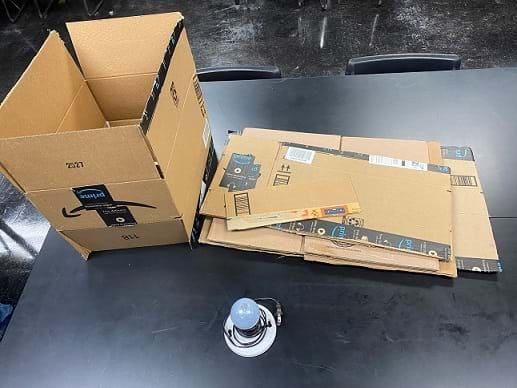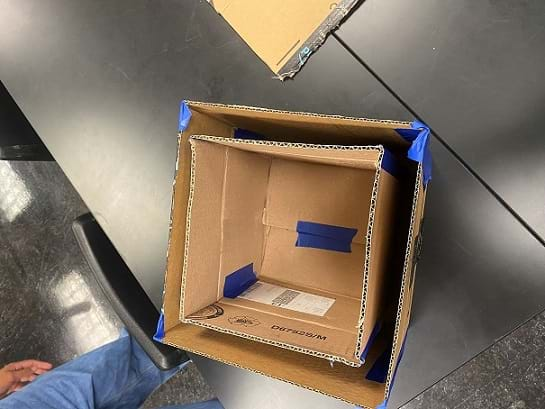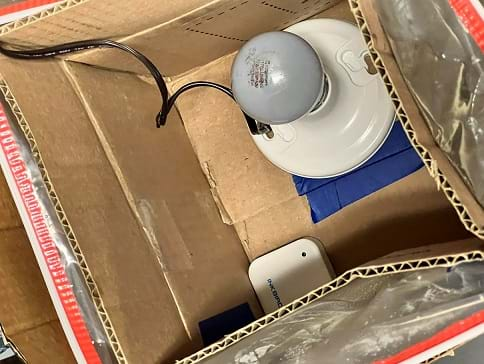Quick Look
Grade Level: 10 (9-11)
Time Required: 4 hours 30 minutes
(six 45-minute class periods)
Expendable Cost/Group: US $0.00
Group Size: 3
Activity Dependency: None
Subject Areas: Physics, Science and Technology
NGSS Performance Expectations:

| HS-PS3-4 |

Summary
How do engineers design materials that are useful to architects for insulation? In this activity, students use a homemade house made from cardboard to investigate heat transfer. They evaluate how long it takes to heat up the inside of the house and then compare it to how long it takes for the house to cool down after the heat source is turned off. From this, they make an evaluation about the effectiveness of the material to be used as insulation as well as if it would be cost effective or sustainable.Engineering Connection
Engineers use different types of material for insulation in different areas of the world as well as different types of buildings. When evaluating new or different materials they need to make measurements about how well the material keeps heat in as well as how long it takes for it to allow heat to “flow out” of the building. This is then combined with the cost and sustainability of the material.
Learning Objectives
After this activity, students should be able to:
- Measure rate of temperature increase and decrease for an enclosed system.
- Graph and evaluate the rate of temperature change.
- Describe the effectiveness of a material to insulate an enclosed system.
- Explain why different materials provide better insulation for thermal energy.
Educational Standards
Each TeachEngineering lesson or activity is correlated to one or more K-12 science,
technology, engineering or math (STEM) educational standards.
All 100,000+ K-12 STEM standards covered in TeachEngineering are collected, maintained and packaged by the Achievement Standards Network (ASN),
a project of D2L (www.achievementstandards.org).
In the ASN, standards are hierarchically structured: first by source; e.g., by state; within source by type; e.g., science or mathematics;
within type by subtype, then by grade, etc.
Each TeachEngineering lesson or activity is correlated to one or more K-12 science, technology, engineering or math (STEM) educational standards.
All 100,000+ K-12 STEM standards covered in TeachEngineering are collected, maintained and packaged by the Achievement Standards Network (ASN), a project of D2L (www.achievementstandards.org).
In the ASN, standards are hierarchically structured: first by source; e.g., by state; within source by type; e.g., science or mathematics; within type by subtype, then by grade, etc.
NGSS: Next Generation Science Standards - Science
| NGSS Performance Expectation | ||
|---|---|---|
|
HS-PS3-4. Plan and conduct an investigation to provide evidence that the transfer of thermal energy when two components of different temperature are combined within a closed system results in a more uniform energy distribution among the components in the system (second law of thermodynamics). (Grades 9 - 12) Do you agree with this alignment? |
||
| Click to view other curriculum aligned to this Performance Expectation | ||
| This activity focuses on the following Three Dimensional Learning aspects of NGSS: | ||
| Science & Engineering Practices | Disciplinary Core Ideas | Crosscutting Concepts |
| Plan and conduct an investigation individually and collaboratively to produce data to serve as the basis for evidence, and in the design: decide on types, how much, and accuracy of data needed to produce reliable measurements and consider limitations on the precision of the data (e.g., number of trials, cost, risk, time), and refine the design accordingly. Alignment agreement: | Energy cannot be created or destroyed, but it can be transported from one place to another and transferred between systems. Alignment agreement: Uncontrolled systems always evolve toward more stable states—that is, toward more uniform energy distribution (e.g., water flows downhill, objects hotter than their surrounding environment cool down).Alignment agreement: Although energy cannot be destroyed, it can be converted to less useful forms—for example, to thermal energy in the surrounding environment.Alignment agreement: | When investigating or describing a system, the boundaries and initial conditions of the system need to be defined and their inputs and outputs analyzed and described using models. Alignment agreement: |
State Standards
Texas - Science
-
The student analyzes the concept of thermal energy. The student is expected to:
(Grades
9 -
12)
More Details
Do you agree with this alignment?
-
contrast and give examples of different processes of thermal energy transfer, including conduction, convection, and radiation; and
(Grades
9 -
12)
More Details
Do you agree with this alignment?
Materials List
Each group needs:
- cardboard (used paper or delivery boxes work great)
- scissors or box cutters
- ruler
- duct tape
- three different household materials that could be used as insulation (students bring materials from home)
- 60-100 W lightbulb
- lightbulb base (available at hardware stores)
- lamp cord (available at hardware stores)
- 2 thermometers
- 4 gallon-size Ziplock bags
- Engineering Notebook – via access to a shared document (such as Google Docs)
- Engineering Notebook Requirements and Rubric
Worksheets and Attachments
Visit [www.teachengineering.org/activities/view/uoh-2668-keep-heat-in-insulation-materials-activity?utm_source=chatgpt.com] to print or download.Pre-Req Knowledge
Students should be able to log data and then create graphs of the data and analyze the graphs. Students should be familiar with the processes of thermal energy transfer (conduction, convection, and radiation).
Introduction/Motivation
What does the term thermal mean? How is thermal energy transferred? (Ask for student answers again looking for conduction, convection, and radiation.)
How does radiation work? (Students should be able to answer that it is through EM waves.) Can you completely stop radiation heat transfer? How can you reduce radiation? (Students may or may not know that it can be achieved through a reflective barrier.) Where within a house might you want to use a reflective barrier? (Answers may include the attic and windows.)
How does convection work? (Students should be able to answer that it is through air flow.) How can you stop convection? (Students may or may not know that it can be achieved by stopping the movement of air.) What are some types of materials that can slow or stop air movement? (Possible answers are fiberglass, wood, cotton, etc.)
How does conduction work? (Students should be able to answer that it is through direct contact of material to material.) How can you stop conduction? (Students may or may not know that you can add insulation of nonconductive materials.) What are some materials used in construction for insulation? (Possible answers are foams and fiberglass.)
Knowing what we know about thermal heat transfer and insulation, what are some types of household materials that could be used as insulation in an emergency? Brainstorm with your partner about different types of materials you could bring into test for being an effective barrier to heat or thermal transfer.
Procedure
Background
Students follow the Project Requirements list in the Engineering Notebook Requirements and Rubric throughout the project. On Day 1, students work on list items 1-3; on Days 3, 4, and 5, they work on items 4 and 5; on Day 6, they work on items 6 and 7.
Note: On Day 1, students brainstorm and select three household materials to use as insulation. They bring these materials into class on Day 2 to test on Day 3. Students might think of materials such as cotton balls, scrap fabric, wool scarves, tissues, newspapers, etc. As appropriate, consider supplementing students’ home-brought materials by gathering some extra materials for students to use.
Before the Activity
- Gather materials.
- Make copies of the Engineering Notebook Requirements and Rubric.
- Prepare all the lights and cords and make sure each lightbulb works.
With the Students
Day 1 
- Break up into groups of 2-4 students (three is ideal). Distribute copies of the Engineering Notebook Requirements and Rubric to groups.
- Discuss heat transfer and brainstorm ideas.
- Select top three ideas and bring materials to class next day.
Day 2 
- Using the scissors and duct tape, construct a box that is approximately 12”x12”x12”.
- Leave a section untapped so that the electrical cord can be slid through.
- Insert an interior wall that is 1” away from the exterior walls all the way around.
- Leave a section untapped so that the electrical cord can be slid through.
- Make a lid for the box.
- Cut a small hole to insert a thermometer at the bottom of the box that allows it to slide in and out.
- Tape a thermometer against the outside wall.
- Place the lightbulb inside the center of the box and slide the electrical cord through the untapped corner.
- Slide second thermometer inside the box and allow to rest on the floor of the box.
Day 3
- Fill the four, gallon-size bags with the selected material and insert in-between the interior and exterior walls all the way around.
- Cover the box.
- Record the initial temperature inside and outside the box and then plug in the lightbulb.
- Record the time and temperature inside and outside every minute. Repeat for 20 minutes.
Day 4
- Repeat steps in Day 3 with new material.
Day 5
- Repeat steps in Day 3 with new material.
Day 6
- Graph data and draw conclusions.
Vocabulary/Definitions
conduction: The conveying of heat or electricity through material.
convection: The transmission of heat in a fluid by the circulation of currents.
insulation: The act of separating a body from others by nonconductors, so as to prevent the transfer of electricity, heat, or sound.
radiation: The transfer of energy via radiation (as opposed to convection or conduction).
thermal: Pertaining to heat or temperature.
Assessment
Pre-Activity Assessment
Discussion: Discuss with the class what the three methods of heat transfer are: conduction, convection, and radiation. Ask questions about how each occur and also how each could possibly be stopped.
Brainstorm: In small groups, have the students brainstorm different household materials that could be used to stop heat transfer. Ensure that students record ideas in their journal.
Activity Embedded (Formative) Assessment
Hypothesize: Each group should select three of their brainstormed materials and provide a reason why each will stop heat transfer. Ensure that students record their hypotheses in their journal.
Measurements: On Day 3, students measure temperatures and record in a spreadsheet. They repeat for two other materials on Days 4 and 5.
Post-Activity (Summative) Assessment
Data Analysis and Conclusion: On Day 6, students:
- Graph the time versus the temperature for each material, for both inside and outside.
- Use the graphs to formulate a conclusion about the effectiveness if the material.
- Write up a conclusion that ranks the materials in effectiveness.
- Describe reasons why each was or was not effective due to the type of material and knowledge about how heat transfer works.
Safety Issues
Ensure that students are careful when connecting their lights into a circuit. Students should connect wires before plugging in the light and be aware of the connection points to the lightbulb when it is plugged in. If desired, provide students with electrical tape to cover any connections.
Subscribe
Get the inside scoop on all things TeachEngineering such as new site features, curriculum updates, video releases, and more by signing up for our newsletter!More Curriculum Like This

Students learn about the nature of thermal energy, temperature and how materials store thermal energy. They discuss the difference between conduction, convection and radiation of thermal energy, and complete activities in which they investigate the difference between temperature, thermal energy and ...

Students learn about the definition of heat as a form of energy and how it exists in everyday life. They learn about the three types of heat transfer—conduction, convection and radiation—as well as the connection between heat and insulation.

With the help of simple, teacher-led demonstration activities, students learn the basic physics of heat transfer by means of conduction, convection and radiation. They also learn about examples of heating and cooling devices, from stove tops to car radiators, that they encounter in their homes, scho...

Students test the insulation properties of different materials by timing how long it takes ice cubes to melt in the presence of various insulating materials. Students learn about the role that thermal insulation materials can play in reducing heat transfer by conduction, convection and radiation, as...
Copyright
© 2023 by Regents of the University of Colorado; original © 2021 University of HoustonContributors
Jason Williamson; Dr. Weihang Zhu; Dr. Kamran AlbaSupporting Program
RET in Advanced Design and Manufacturing , University of HoustonAcknowledgements
This curriculum was developed under National Science Foundation RET grant no. 1855147— Research Experience for Teachers in Advanced Design and Manufacturing at the University of Houston. Any opinions, findings and conclusions or recommendations expressed in this material are those of the authors and do not necessarily reflect the views of the National Science Foundation.
Last modified: March 16, 2023










User Comments & Tips